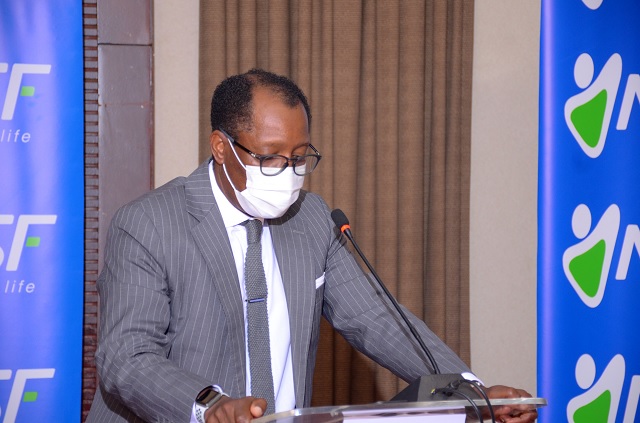
Kampala, Uganda | THE INDEPENDENT | The National Social Security Fund is likely to give a lower interest to savers for the year 2020/21, than what was paid out last year, according to the economic conditions prevailing.
The decision to raise, lower or maintain the interest rate largely depends on two factors, the inflation rate over the last 10 years and the performance of the fund.
According to the policy on interest rates to savers, the rate is supposed to be 2 points above the the average national inflation rate of the previous 10 years.
Over the last decade, inflation has been declining and in 2020 it was 3.8%, though it is expected to end this year at a higher 5.7%, according to the Uganda Bureau of Statistics.
Taking the 10-year inflation average, this has also been declining, though in a fluctuating form, and is currently about 4.3 percent, having dropped from a 5.82 percent in 2019/2020.
In that year however, an interest rate of 10.75% was declared, which was more than 4 percentage points, instead of the 2 percentage points set out in the policy.
So the NSSF management has the prerogative to set any rate provided it’s above the inflation rate plus 2 points.
That notwithstanding, the Minister for Finance, Planning and Economic Development, has the final say and in 2018, Minister Matia Kasaija overruled the NSSF management and declared an interest of 15%, the highest.
Currently, the average inflation for 10 years has gone down and hence the benchmark.
“Our benchmark for 10 year average inflation came down to about 4.3% and that figure is where we benchmark the interest that we pay to our members,” says Richard Byarugaba, the NSSF managing director.
In setting the interest rate, the NSSF also takes into account it’s financial performance in the year under review, and this was the main reason the minister set the high 15 percent.
The fund reports posting a comprehensive income of 1.84 trillion shillings, having grown by a quarter from 1.472 trillion shillings, mainly due a to an increase in the treasury bond in the fixed income.
Interest income grew from 1.40 trillion to 1.61 trillion Shillings, while dividend income grew from 62.2billion to 7.49billion Shillings, due to better business on stock markets in the region, where NSSF invested in stocks.
“Most of the equity markets in the East African region recovered, there was a very good gain on the Nairobi stock exchange that grew by 26%, a modest increase on the Uganda stock exchange by about 1.9% and on the Dar es Salaam market that grew by 4.8%,” says Byarugaba.
The returns on investments outside the country were however affected by the appreciation of the Uganda shilling against foreign currencies, especially the US Dollar and the Kenya shillings.
“The Uganda shilling appreciated against the Kenya shilling by 6.1% and also appreciated against the US Dollar by 4.7%. However, although our assets might have increased in foreign currency, if you translate it back into shillings, the figure is lower,” he explains.
The investment on local companies and the real estate projects in the other had, performed well.
“15 percent of our investments go to equities and the equity space did really well, same for real estate where there has been some impact in form of sales.
“From the performance, you will notice that our assets under management grew by 17%, which is higher than the growth rate of the economy. So the fund is truly a UGX 15.5 trillion ($4.4billion) fund.”
Meanwhile, benefits paid to members grew by 29 percent from 496.4 billion in 2019/20 to 642.3 billion shillings in 2020/21 due to an increased number of claimants.
By September 19th, the Fund had paid out 1,785,943,795 billion shillings to qualifying members who were diagnosed with COVID-19.
It is estimated that this has grown to 2 billion shillings, paid to about 60 beneficiaries.
This translates to about 33 million per person who benefitted.
There was also a significant increase in the contributions, driven by a response to the amnesty given to employers.
“At the beginning of the pandemic, we issued an amnesty and about 1,700 companies took advantage of that which represented 20% of our contributions, as we approached the end of the year, these companies actually paid back,” said Byarugaba. “In spite of that, we were still able to increase collections.”
Benefits paid to qualifying members increased by 29 percent from 496.4 billion shillings in 2019/2020 to 642.3 billion shillings in 2020/21. The growth is attributed to an increase in number of claimants.
*****
URN
 The Independent Uganda: You get the Truth we Pay the Price
The Independent Uganda: You get the Truth we Pay the Price


